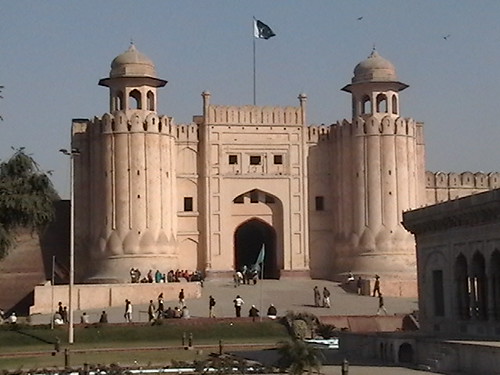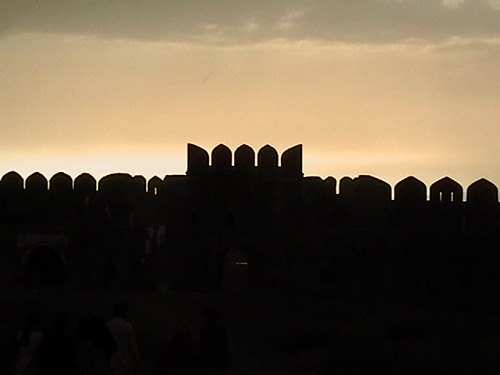























Pakistan's Architectural Heritage
Slideshow by jalalspages
Pakistan inherited a rich architectural heritage and the new structures coming up are reflective of its past aspirations. This is a review of the past and the present
1910 views since May 25, 2007.
Get a link button for this slideshow »
Make and share your own slideshow »
1 of 24
Badshahi Mosque
Entering Lahore from the Grand Trunk (GT) Road from the north, two landmarks of Lahore come to the view - the Minar-e-Pakistan and the grand Badshahi Mosque, displaying their splendours and majestic architecture to the on lookers. It is one of the city's best known landmarks, and a major tourist attraction, and a reminder of the beauty and grandeur of the Mughal era architecture.
This grand mosque with the biggest courtyard of any mosque around the world was built by the Mogul emperor Aurangzeb in the 17th century (1674 to be exact). Its construction was completed in a record time of two and a half years. Aurangzeb built the mosque which is bigger than the Friday Mosque in New Delhi, built by his father Shah Jehan. The mosque is entirely made of marble and red stand stone. Its main entrance measures 21.33 meters in length and a courtyard of 161.5 x 160.6 meters. The marble domes cover seven prayer chambers, surrounded by four minarets at the four corners of the mosque, each with an outer circumference of 20 meters, soaring up to 54 meters. The walls and roofs of the prayer halls have tastefully decorated with Islamic calligraphy, traditional Persian tile sheathing and fresco. The use of stone and marble for exteriors and interiors lends the mosque a solid monumentality.
For more information, please visit www.pakistanpaedia.com/landmarks/badshahi_mosque-lahore.htm
Photo by jalalspages
2 of 24
Badshahi Mosque
View of Badshahi Mosque from Lahore Fort (Sheesh Mahal Pavillion)
Photo by jalalspages
3 of 24
Badshahi Mosque and Iqbal's Tomb
Poet Allam Iqbal's tomb outside the entrance of the badshahi Mosque
Photo by jalalspages
5 of 24
Badshahi Mosque
Beautiful carving on the entrane to the Badshahi Mosque built Mogul emperor Aurangzeb
Photo by jalalspages
6 of 24
Lahore Fort
Shahi Qilla as seen from the footsteps of the Badshahi Mosque
The city of Lahore has been seat of every successive government in India and specially the Punjab. Therefore one comes across a plentiful of structures and monuments that dot the landscape of Lahore. But two specimens of Mogul architecture cannot escape the eye of anyone entering Lahore from Rawalpindi on the Grand Trunk Road; the Badshahi Mosque and the Shahi QIlla or the Royal Fort.
The fort was initially constructed in 1566 AD by the Mughal Emperor Akbar, on the ruins of a mud fort which existed as early as 1021 AD. The Fort is rectangular and is located in the north western corner of Lahore, adjacent to the Walled City. It has 13 gates. The main gates are located alongside the centre of the western and eastern walls. Located centrally in the city of Lahore, the Lahore Fort is a magnificent fortified palace complex. Its elaborate Mughal architecture is straight out of a storybook of the Mysterious East. The impressive twin-domed entrance leads into elaborately decorated courtyards and pavilions with water features, some with still intact sumptuous wall decorations of inlaid semiprecious stones and painted designs. It's large enough to allow several elephants carrying members of the royal family to enter at one time. There are a flight of stone steps specially built for ceremonial elephant processions.
For more information, please visit www.pakistanpaedia.com/landmarks/fort/lahore_fort.htm
Photo by jalalspages
8 of 24
Lahore Fort
The massive Alamgiri Gate Lahore Fort (Shahi Qilla)
The fort was initially constructed in 1566 AD by the Mughal Emperor Akbar, on the ruins of a mud fort which existed as early as 1021 AD. The Fort is rectangular and is located in the north western corner of Lahore, adjacent to the Walled City. It has 13 gates. The main gates are located alongside the centre of the western and eastern walls. Located centrally in the city of Lahore, the Lahore Fort is a magnificent fortified palace complex. Its elaborate Mughal architecture is straight out of a storybook of the Mysterious East. The impressive twin-domed entrance leads into elaborately decorated courtyards and pavilions with water features, some with still intact sumptuous wall decorations of inlaid semiprecious stones and painted designs. It's large enough to allow several elephants carrying members of the royal family to enter at one time. There are a flight of stone steps specially built for ceremonial elephant processions.
Photo by jalalspages
9 of 24
View of Badshahi Mosque from Lahore Fort
View of Badshahi Mosque from the Sheesh Mahal Pavillion - Lahore Fort
Photo by jalalspages
10 of 24
View of Minar-e-Pakistan from Lahore Fort
View of Minar-e-Pakistan from Sheesh Mahal Pavillion - Lahore Fort
Photo by jalalspages
11 of 24
Minar-e-Pakistan
Minar-e-Pakistan. The monument was constructed on the place where the famous Pakistan Resolution was passed on 23 March 1940 wherein the Muslims of British India demanded a separate homeland. Muhammad Ali Jinnah, president All India Muslim League presided over the meeting attended by hundred and thousands of the Muslims.
For more information, please visit www.pakistanpaedia.com/minar/minar-e-pakistan.htm
Photo by jalalspages
12 of 24
Minar-e-Pakistan
Badshahi Mosque as seen from the main floor of Minar-e-Pakistan
Photo by jalalspages
13 of 24
Rohtas
Rohtas Fort built in the 16th century by the mastermind of the Grand Trunk Road - Sher Shah Suri, the then Muslim ruler of India. The approach road to Rohtas is just 3 kilometres short of Dina, a small town ahead of Jhelum on Lahore - Islamabad Road. From the main GT Road, Rohtas is only 8 kilometres away, located south-west of Dina town. The work started in 1541 AD and completed in 9 years. There are many estimates in various scripts as far its cost of construction is concerned. Some place it around Rs. 3,425,000, while a Persian script puts the cost of construction and maintaining an army at around Rs. 110,107,975. At one place it says that one gold coin ("Ashraffi") was given for each brick that was placed.
For more information/pictorial of this massive fort, please visit www.pakistanpaedia.com/landmarks/rohtas/rohtas.htm
Photo by jalalspages
15 of 24
Rohtas
The Shahi (royal) Mosque - once Kings and princes offered their prayers here - now it is a desolate place
Photo by jalalspages
17 of 24
Rohtas
The towering bastions - sunbaked and blackened over the centuries
Photo by jalalspages
19 of 24
Zamzamma
Zamzamma - Built on the orders of Ahmad Shah Abdali, the Afghan who ruled India in 18th century. The massive gun made of brass and bronze fired 1 ton shell. The gun wsa later captured by the Sikhs of Bhangi clan and thus came to be known as Bhangian di Tope. The gun was used by Ranjit Singh to storm Multan Fort. The famous British writer Rudyard Kipling also sat under the shadow of this giant gun to write, thus aslo came to be known as Kim's gun. The gun is now placed infront of Lahore Museum. Read more about it at www.pakistanpaedia.com/landmarks/bhangioun%20ki%20tope.htm
Photo by jalalspages
20 of 24
GCU
Government College - a name which without any suffix means the Government College Lahore - a unique tribute to this over hundred and forty years old educational institution which was founded in 1864. Its graduates are called "Ravian" for the River Ravi that flows by just a few miles from the college. It is a traditional institution having produced a large number of celebrated men in all walks of life. Dr Sir Allama Muhammad Iqbal and Dr Abdus Salam are the most notable and revered Ravians.
The college was established on 1st January 1864 in the Zilla School in a portion of Raja Dhyan Singh's Haveli. In April 1871 the college moved to a large Bungalow near Anarkali. In 1873 its location was changed to another house called Rahim Khans Kothi. The college moved to its present massive infrastructure in 1876. The construction had started almost in mid 1872 and was completed in 1877. Situated in the heart of the city, the site is surrounded by main business and administrative areas, schools, colleges and Punjab University old Campus. Presently raised to the status of university, Government College University (GCU) site is located at the junction of the Mall and the Lower Mall and occupies a focal point. However, it is still popularly called GC.
Photo by jalalspages
23 of 24
Lahore Food Street
The old house above the Lahore Food Street have been tastefully decorated with low and bright lights to add colours to the arena
Photo by jalalspages
24 of 24
Lahore Food Street
The old house above the Lahore Food Street have been tastefully decorated with low and bright lights to add colours to the arena
Photo by jalalspages

